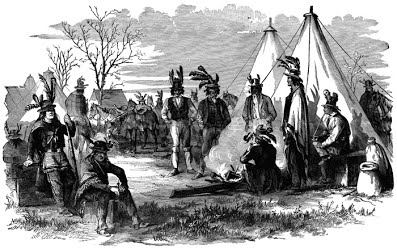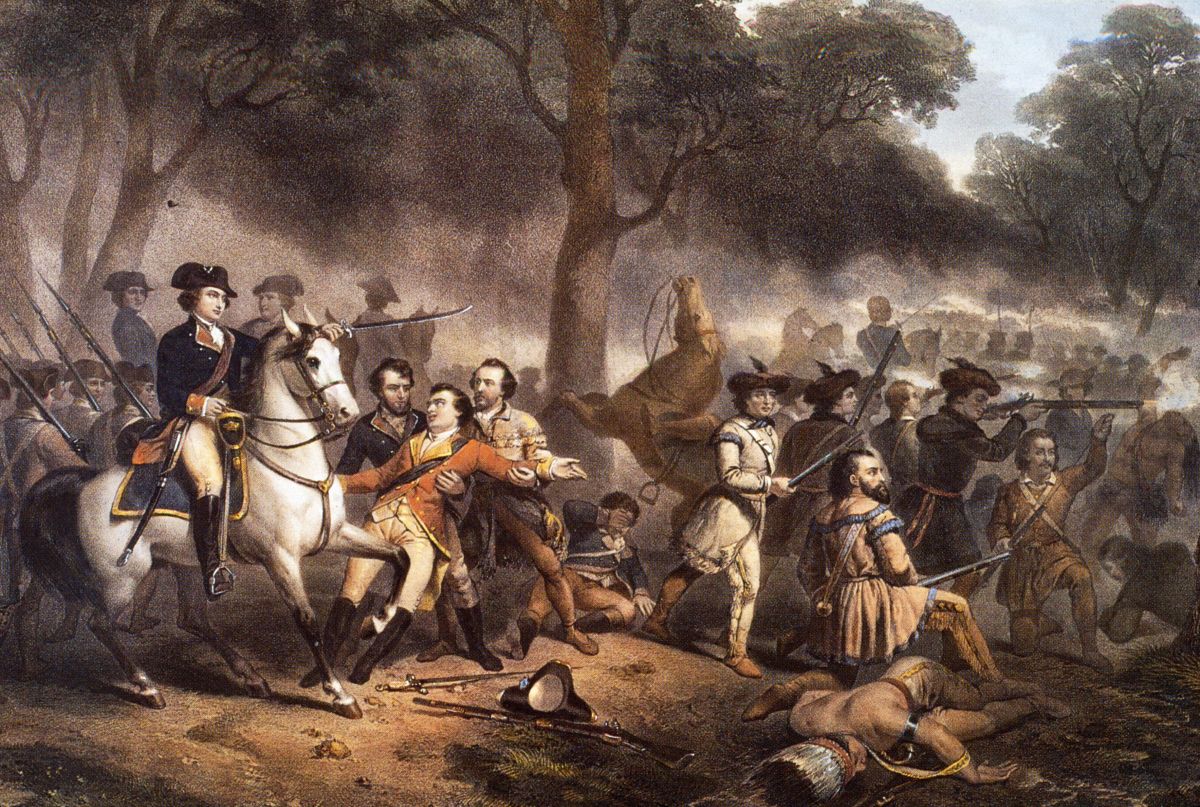The Lenape, also called the Lenni Lenape and Delaware, are Native American people of the Northeastern Indian Tribes who live in Canada and the United States.

Their historical territory included New Jersey and eastern Pennsylvania along the Delaware River watershed, New York City, western Long Island, and the Lower Hudson Valley.
Jump to:
Lenape kinship system has matrilineal clans. That is, children belong to their mother's clan, from which they gain social status and identity.
The mother's eldest brother was more significant as a mentor to the male children than was their father, who was generally of another clan. Hereditary leadership passed through the maternal line, and women elders could remove leaders of whom they disapproved.
Agricultural land was managed by women and allotted according to the subsistence needs of their extended families. Families were matrilocal; newlywed couples would live with the bride's family, where her mother and sisters could also assist her with her growing family.
During the Beaver Wars in the first half of the 17th century, European colonists were careful to keep firearms from the coastal tribes located in Delaware, while rival Iroquoian peoples such as the Susquehannocks and Confederation of the Iroquois became comparatively well-armed.
Subsequently, the Lenape became subjugated and made tributary to first the Susquehannocks, then the Iroquois, even needing their rivals' agreement to initiate treaties such as land sales.
Like most tribes, Lenape communities were weakened by newly introduced diseases originating in Europe, mainly smallpox but also cholera, influenza, and dysentery, and recurrent violent racial conflict with Europeans. Iroquoian peoples occasionally fought the Lenape.
As the 18th century progressed, many surviving Lenape moved west into the (relatively empty) upper Ohio River basin.
During the decades of the 18th century, most Lenape was pushed out of their homeland by expanding European colonies. Their dire situation was exacerbated by losses from intertribal conflicts.
The divisions and troubles of the American Revolutionary War and the United States' independence pushed them farther west. In the 1860s, the United States government sent most Lenape remaining in the eastern United States to the Indian Territory under the Indian Removal policy.
In the 21st century, most Lenape now reside in the US state of Oklahoma, with some communities living also in Wisconsin, Ontario, and in their traditional homelands.
Lenape Tribe Facts: Territory and Language

Traditional Lenape lands, the Lenapehoking, was a large territory that encompassed the Delaware Valley of eastern Pennsylvania, especially the Poconos and New Jersey, from the north bank of Lehigh River along the left bank of Delaware thence south into Delaware and the Delaware Bay.
Their lands also extended west from western Long Island and New York Bay, across the Lower Hudson Valley in New York into the lower Catskills and a sliver of the upper edge of the North Branch Susquehanna River.
On the west side, the Lenape lived in numerous small towns along the rivers and streams that fed the waterways and likely shared the hunting territory of the Schuylkill River watershed with the rival Iroquoian Susquehannock.
The Unami and Munsee languages belong to the Eastern Algonquian language group. Although the Unami and Munsee speakers people are related, they consider themselves as distinct, as they used different words and lived on opposite sides of the Kittatinny Mountains of modern Pennsylvania.
Today, only elders speak the language, although some young Lenape youth and adults learn the ancient language.
Lenape Tribe Facts: History
First Contact with Europeans: The first recorded contact with Europeans presumed to have been the Lenape was in 1524. The explorer Giovanni da Verrazzano was greeted by local Lenape, who came by canoe after his ship entered what is now called Lower New York Bay.

The early interaction between the Lenape and Dutch traders in the 17th century was primarily through the fur trade; specifically, the Lenape trapped and traded beaver pelts for European-made goods.
According to Dutch settler Isaac de Rasieres, who observed the Lenape in 1628, the Lenape's primary crop was maize, which they planted in March. They quickly adopted European metal tools for this task.
In May, the Lenape planted kidney beans near the maize plants; the latter served as props for the climbing bean vines. They also planted squash, whose broad leaves cut down on weeds and conserved moisture in the soil.
The women devoted their summers to fieldwork and harvested the crops in August. Women cultivated varieties of maize, squash, and beans and did most of the fieldwork, processing, and cooking of food.
The men limited their agricultural labor to clearing the field and breaking the soil. They primarily hunted and fished during the rest of the year.
Other methods of hunting included lassoing and drowning deer, as well as forming a circle around prey and setting the brush on fire.
Early Colonial Era: At the time of sustained European contact in the 16th centuries and 17th centuries, the Lenape were a powerful Native American nation who inhabited a region on the mid-Atlantic coast spanning the latitudes of southern Massachusetts to the southern extent of Delaware in what anthropologists call the Northeastern Woodlands.
Although never politically unified, the confederation of the Delaware tribes roughly encompassed the area around and between the Delaware tribes and lower Hudson rivers and included the western part of Long Island in present-day New York.
Some of their place names, such as Manhattan, Raritan, and Tappan, were adopted by Dutch and English colonists to identify the Lenape people who lived there.
Based on the historical record of the mid-seventeenth century, it has been estimated that most Lenape polities consisted of several hundred people, but it is conceivable that some had been considerably larger prior to close contact, given the wars between the Susquehannocks and the Iroquois, both of whom were armed by the Dutch fur traders, while the Lenape were at odds with the Dutch and so lost that particular arms race.
Smallpox devastated native communities, even located far from European settlements by the 1640s. The Lenape and Susquehannocks fought a war in the middle of the 17th century that left the Delaware a tributary state even as the Susquehannocks had defeated the Province of Maryland between 1642-50s
17th Century: New Amsterdam was founded in 1624 by the Dutch in what would later become New York City. Dutch settlers also founded a colony at present-day Lewes, Delaware, on June 3, 1631, and named it Zwaanendael (Swan Valley).
The colony had a short life, as, in 1632, a local band of Lenape killed the 32 Dutch settlers after a misunderstanding escalated over Lenape's defacement of the insignia of the Dutch West India Company.
In 1634, the Iroquoian-speaking Susquehannock went to war with the Lenape over access to trade with the Dutch at New Amsterdam. They defeated the Lenape, and some scholars believe that the Lenape may have become tributaries to the Susquehannock.
After the warfare, the Lenape referred to the Susquehannock as "uncles." The Iroquois added the Lenape to the Covenant Chain in 1676; the Lenape were tributary to the Five Nations (later Six) until 1753, shortly before the outbreak of the French and Indian War.

The Lenape's quick adoption of trade goods and their need to trap furs to meet high European demand resulted in their disastrous over-harvesting of the beaver population in the lower Hudson Valley. With the fur sources exhausted, the Dutch shifted their operations to present-day upstate New York.
The Lenape who produced wampum in the vicinity of Manhattan Island temporarily forestalled the negative effects of the decline in trade.
The Lenape population fell sharply during this period due to high fatalities from epidemics of infectious diseases carried by Europeans, such as measles and smallpox, to which they had no natural immunity, as the diseases had arisen on the Asian continent and moved west into Europe, where they had become endemic in the cities.
The Lenape had a culture in which the clan and family controlled property. Europeans often tried to contract for land with the tribal chiefs, confusing their culture with that of neighboring tribes such as the Iroquois.
The Lenape would petition for grievances on the basis that not all their families had been recognized in the transaction.
After the Dutch arrival in the 1620s, the Lenape were successful in restricting Dutch settlement until the 1660s to Pavonia.
The Dutch finally established a garrison at Bergen, which allowed settlement west of the Hudson within the province of New Netherland. This land was purchased from the Lenape after the fact.
In 1682, William Penn and Quaker colonists created the English colony of Pennsylvania, beginning at the lower Delaware River. A peace treaty was negotiated between the newly arriving English and Lenape at what is now known as Penn Treaty Park.

In the decades immediately following, some 20,000 new colonists arrived in the region, putting pressure on Lenape settlements and hunting grounds.
Although Penn endeavored to live peaceably with the Lenape and to create a colony that would do the same, he also expected his authority and that of the colonial government to take precedence.
His new colony effectively displaced many Lenape and forced others to adapt to new cultural demands. Penn gained a reputation for benevolence and tolerance, but his efforts resulted in more effective colonization of the ancestral Lenape homeland than previous ones.
18th Century - Today: William Penn died in 1718. His heirs, John and Thomas Penn, and their agents were running the colony and had abandoned many of the elder Penn's practices. Trying to raise money, they contemplated ways to sell Lenape land to colonial settlers.
The resulting scheme culminated in the so-called Walking Purchase.
In the mid-1730s, colonial administrators produced a draft of a land deed dating to the 1680s. William Penn had approached several leaders of Lenape polities in the lower Delaware to discuss land sales further north.
Since the land in question did not belong to their polities, the talks came to nothing. However, colonial administrators had prepared the draft that resurfaced in the 1730s.
The Penns and their supporters tried to present this draft as a legitimate deed. Lenape leaders in the lower Delaware refused to accept it.
During the French and Indian War, the Lenape initially sided with the French, as they hoped to prevent further British colonial encroachment in their territory. However, such leaders as Teedyuscung in the east and Tamaqua in the vicinity of modern Pittsburgh shifted to building alliances with the English.
During the American Revolution, the Munsee-speaking Lenape bands of the Ohio Country were deeply divided over which side, if any, to take in the conflict. Their bands lived in numerous villages around their main village of Coshocton.
At the time of the Revolutionary War, the Lenape villages lay between the western frontier strongholds of the British and the Patriots: the American colonists had Fort Pitt, and the British, with Indian allies, controlled the area of Fort Detroit.
The Lenape suffered a similar fate as the other natives and were continually pushed west.
Today, three Lenape tribes are federally recognized in the United States. They are as follows:
- Delaware Nation, Anadarko, Oklahoma
- Delaware Tribe of Indians, Bartlesville, Oklahoma
- Stockbridge-Munsee Community, Bowler, Wisconsin.
Lenape Tribe Facts: Online Resources
- Wikipedia - Lenape Tribe
- Lenape Lifeways
- Official Delaware Indian Website
- Family Search - Lenape and Delaware Indian Genealogy
- Native Languages - Lenape Culture
- William Penn's Description of Lenape Indians
- The History Junkie's Guide to Native American History
- The History Junkie's List of Native American Tribes
- The History Junkie's Guide to Colonial America
